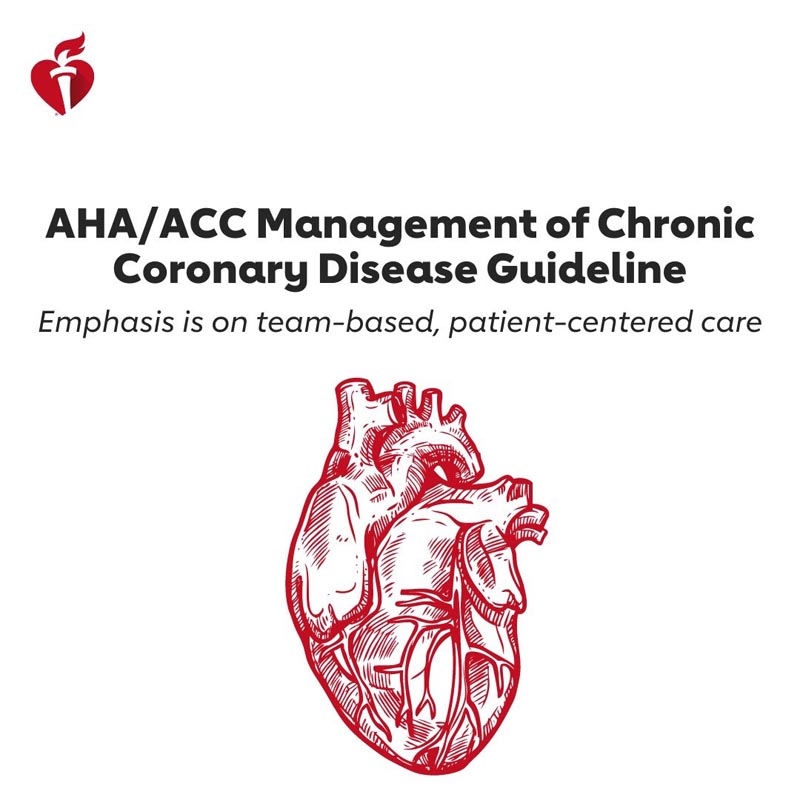
Goals
The “2023 AHA/ACC/ACCP/ASPC/NLA/PCNA Guidelines for the Treatment of Patients with Chronic Coronary Heart Disease” provides an update and consolidates new evidence since the “2012 ACCF/AHA/ACP/AATS/PCNA/SCAI/STS Guidelines for the diagnosis and treatment of patients with stable ischemic heart disease” and the corresponding “2014 ACC/AHA/AATS/PCNA/SCAI/STS Focused Update of the Guide for the diagnosis and management of patients with stable ischemic heart disease.”
Methods
A comprehensive literature search was conducted from September 2021 to May 2022. Clinical studies, systematic reviews and meta-analyses, and other evidence conducted in human participants were identified that were published in English in MEDLINE (via PubMed), EMBASE, the Library Cochrane, the Agency for Healthcare Research and Quality, and other selected databases relevant to this guideline.
Structure
This guideline provides an evidence-based, patient-centered approach to the management of patients with chronic coronary heart disease, considering the social determinants of health and incorporating the principles of shared decision-making and team-based care. Relevant topics include general approaches to treatment decisions, guideline-directed management and therapy to reduce symptoms and future cardiovascular events, decision making related to revascularization in patients with chronic coronary artery disease, recommendations for management in special populations, follow-up. and patient monitoring, gaps in evidence and areas needing future research.
Where appropriate, and based on the availability of cost-effectiveness data, cost-value recommendations for clinicians are also provided. Many previously published guideline recommendations have been updated with new evidence, and new recommendations have been created when supported by published data.
Expected use
Clinical practice guidelines provide recommendations applicable to patients with or at risk of developing cardiovascular disease (CVD). The focus is on medical practice in the United States, but these guidelines are relevant to patients around the world. While the guidelines may be used to inform regulatory or payer decisions, the intent is to improve the quality of care and align with patient interests. The guidelines are intended to define practices that meet patients’ needs in most, but not all, circumstances and should not replace clinical judgment.
Managing clinical implementation
According to guideline recommendations, it is effective only when followed by both doctors and patients. Adherence to recommendations can be improved through shared decision-making between clinicians and patients, with patient involvement in selecting interventions based on individual values, preferences, and associated conditions and comorbidities.
The 10 key messages of the guide 1. Emphasis is on patient-centered, team-based care that considers social determinants of health along with associated costs, while incorporating shared decision-making in risk assessment, testing, and treatment. 2. Non-pharmacological therapies, including healthy dietary habits and exercise, are recommended for all patients with chronic coronary heart disease (CHD). 3. Patients with chronic coronary heart disease (CHD) who do not have contraindications are recommended to participate in regular physical activity , including activities to reduce sitting time and increase aerobic and resistance exercise. Cardiac rehabilitation for eligible patients provides significant cardiovascular benefits, including decreased morbidity and mortality outcomes. 4. The use of sodium-glucose cotransporter 2 inhibitors and glucagon-like peptide-1 receptor agonists is recommended for select groups of patients with chronic coronary heart disease (CHD), including groups without diabetes. 5. New recommendations for the use of beta blockers in patients with chronic coronary heart disease (CHD): (a) Long-term beta-blocker therapy is not recommended to improve outcomes in patients with chronic coronary heart disease (CHD) in the absence of myocardial infarction in the past year, left ventricular ejection fraction ≤50%, or other primary indication for beta-blocker therapy. (b) A calcium channel blocker or beta blocker is recommended as first-line antianginal treatment. 6. Statins remain the first-line therapy for lipid lowering in patients with chronic coronary heart disease (CHD) . Several adjuvant therapies (e.g., ezetimibe, PCSK9 [proprotein convertase subtilisin/kexin type 9] inhibitors, inclisiran, bempedoic acid) may be used in select populations, although clinical outcome data are not available for newer agents such as inclisiran. . 7. Shorter durations of dual antiplatelet therapy are safe and effective in many circumstances, particularly when the risk of bleeding is high and the risk of ischemia is low to moderate. 8. The use of dietary or over-the-counter supplements, including fish oil and omega-3 fatty acids or vitamins, is not recommended in patients with chronic coronary heart disease (CHD) due to lack of benefit in reducing cardiovascular events. 9. Routine periodic anatomic or ischemic testing without a change in clinical or functional status is not recommended for risk stratification or to guide therapeutic decision making in patients with chronic coronary heart disease (CHD). 10. Although e-cigarettes increase the likelihood of successful smoking cessation compared to nicotine replacement therapy, due to the lack of long-term safety data and the risks of sustained use, e-cigarettes are not recommended as First-line therapy for smoking cessation. |
Comments and recommendations for patients
New guidelines detailing how to care for people with heart disease come with some easy-to-understand warnings for patients.
The chronic coronary heart disease guidelines from the American Heart Association and the American College of Cardiology, published in the AHA journal Circulation , are not an incremental update, said Dr. Salim Virani, chairman of the expert panel that rewrote them.
"It’s actually a new guideline in which everything that needed to be evaluated in terms of evidence was reviewed and all the recommendations were rewritten," said Virani, vice chancellor for research and professor of medicine at Aga Khan University in Karachi, Pakistan.
Coronary heart disease includes several conditions that can be traced back to the buildup of plaque on the walls of arteries that limits blood flow to the heart. That includes coronary artery disease, angina, heart attack, and care after a procedure to open a blocked heart artery.
The guidelines cover topics ranging from exercise to cholesterol control and bypass surgery. "This brings everything together as a one-stop shop for providers who care for these types of patients," said Dr. Kristin Newby, vice chair of the writing panel.
Here are six warnings for people with coronary heart disease, plus a general message to accept.
Avoid trans fats
"Trans fats are not good for anyone," said Newby, a professor of medicine and cardiology at Duke University in Durham, North Carolina. But people with coronary heart disease should be very careful.
Of all the fats and oils used in cooking, Newby said, trans fats are the most likely to cause plaques in the arteries. In people with existing diseases, trans fats have been linked to an increased risk of heart attack and stroke, higher death rates from those problems, and an increased risk of premature death.
Artificial trans fats are liquid oils that have been converted to solids. Margarine and shortening are common examples. The Food and Drug Administration (FDA) has banned food manufacturers from using a once-common source of trans fats: partially hydrogenated vegetable oils. But in some places, trans fats still show up in restaurant fryers and other places.
Trans fats also occur naturally in beef, lamb, and butterfat, but the guidelines say they pose fewer risks than artificial trans fats.
Companies can say a food is free of trans fat even if it has up to half a gram. To avoid trans fats, check nutrition labels and skip fried foods, processed baked goods, and refrigerated dough. And look for terms like "partially hydrogenated oils" in the ingredients list.
Beware of secondhand smoke
Smoking is a well-known cause of heart disease. But even if you’re not smoking, you should be careful.
"Everything should be done to avoid secondhand smoke , because it carries many of the same chemicals and irritants that we think lead to coronary heart disease," Newby said.
It’s a matter of cumulative risk, Virani said. "If you have heart disease and then add secondhand smoke on top of everything else that’s going on, the risk really increases." For people who have had a heart attack, that includes an increased risk of having another one. Avoiding secondhand smoke can be difficult if you work in a place where smoking is allowed. But if you have a family member who smokes, Virani said, "at a minimum" you should ask them to smoke outside.
Be careful with common medications, including ibuprofen.
"Many times we all have the misperception that if something is available without a prescription, it is safe," Virani said. "Patients who have heart disease need to be very careful, even if it involves vitamins."
The guidelines offer a specific warning about nonsteroidal anti-inflammatory drugs, also known as NSAIDs. These medications include ibuprofen and naproxen sodium. "What we’re talking about here is not single use because muscles hurt after exercising," Newby said. “What we’re talking about is using them every day.”
NSAIDs pose two problems for people with coronary heart disease, Virani said. First, long-term use has been linked to cardiovascular problems, including a second heart attack. Second, NSAIDs can cause bleeding in the stomach and intestines. A heart patient may be taking one or even two blood-thinning medications, Virani said. Combine them with NSAIDs and "your risk of bleeding increases greatly." Occasional use is not a problem, he said. But he and Newby recommend acetaminophen as an alternative.
Do not combine erectile dysfunction medications with nitrates
Nitrates, including nitroglycerin, are prescribed for angina or chest pain. Phosphodiesterase type 5 inhibitors, including sildenafil and tadalafil, are used for erectile dysfunction. Mixing them can cause a life-threatening drop in blood pressure. "It’s not about not using them," Newby said. "It’s just about being careful."
Tadalafil, for example, can remain in the system for up to 48 hours, and some nitrates are also long-acting. Men should talk to their doctor about how long medications last in their system and look for alternatives if necessary, experts said.
Do not use these medications to lose weight
Sympathomimetic weight loss medications , such as phentermine and benzphetamine, suppress appetite. They also raise heart rate and blood pressure, which can strain a heart that already suffers from compromised blood flow, Virani said. The medications could also cause irregular heartbeats, he said. One drug in this class, sibutramine, was withdrawn from the U.S. market in 2010, but it could be available outside the country or sold illegally. Avoid them all, Virani said. "We have much, much better, safer weight loss medications."
Be careful with postmenopausal hormone therapy
Estrogens and progestins are given to women to help with postmenopausal symptoms, such as hot flashes. Against the background of heart disease, you have problems.
First, Newby said, although hormones have been studied extensively in hopes of showing that they protect against heart disease, intensive research has found no benefit. But hormone therapy increases the risk of venous thromboembolism, a blood clot in a deep vein or lung.
"What we suggest to patients with chronic coronary heart disease is to actually have that conversation with their treating doctor to see what other alternatives are out there," Virani said. Given their already high risk, "they have to be very careful."
And now the good news…
Managing chronic coronary heart disease can seem like a list of limitations. Virani said it should also be seen as a wealth of opportunities.
"You know, 30 or 40 years ago, having chronic coronary heart disease was really like, ’Okay, you’re going to have another heart attack one of these days, and you may or may not survive,’" he said. But even in the last four or five years, new treatments have made it more manageable than ever if people work with their health care professionals and take their medications. "So there’s also a lot of hope," she said. "It’s no longer a death sentence. You can have a fairly normal life and a good quality of life if you really follow the recommendations."
* Download the full text of the guide in English in PDF format here .

















